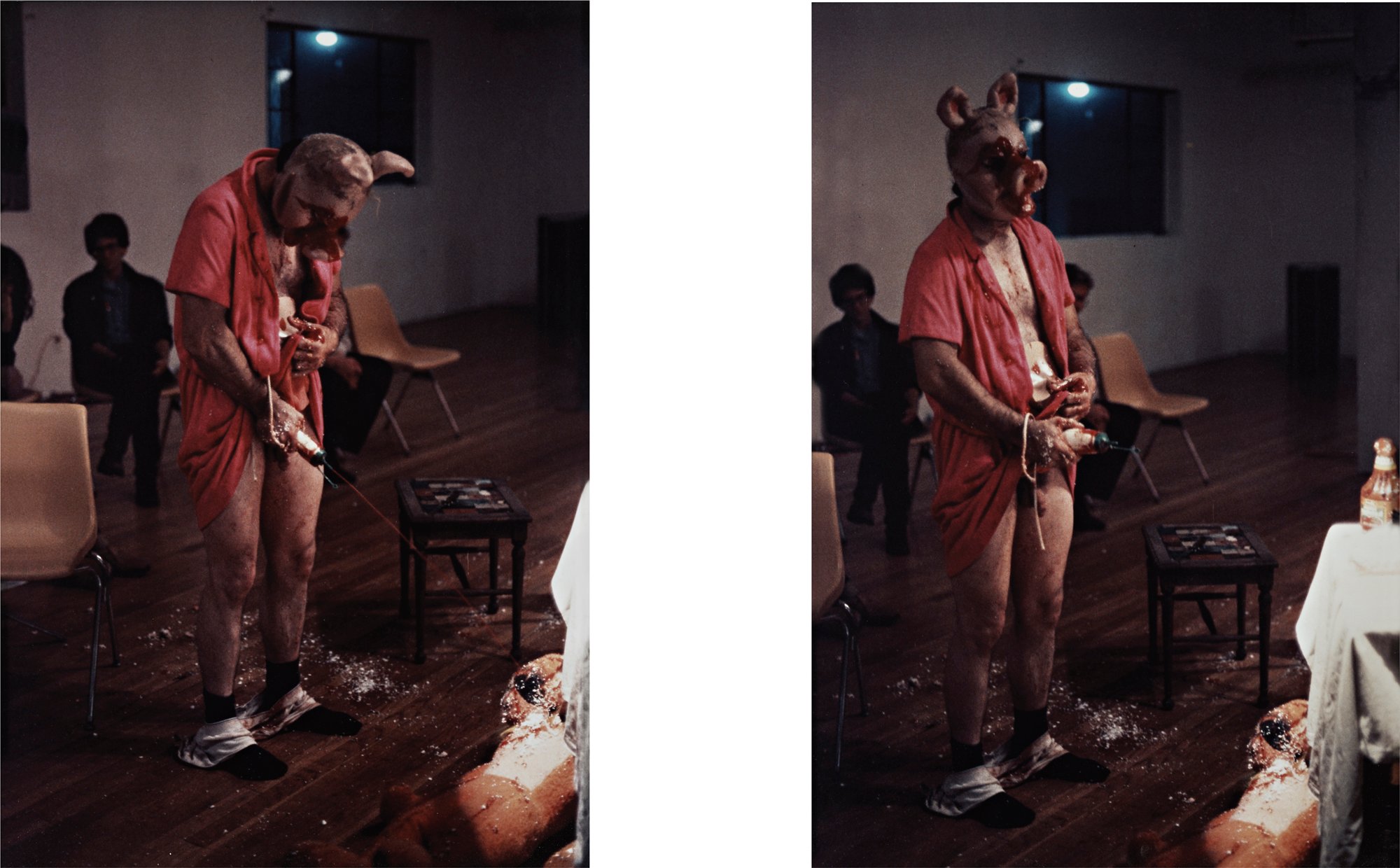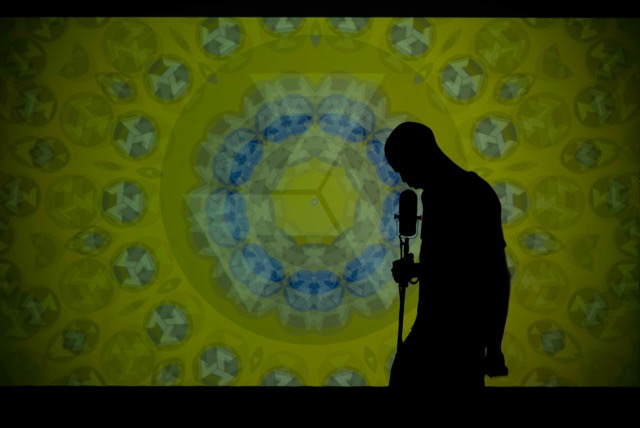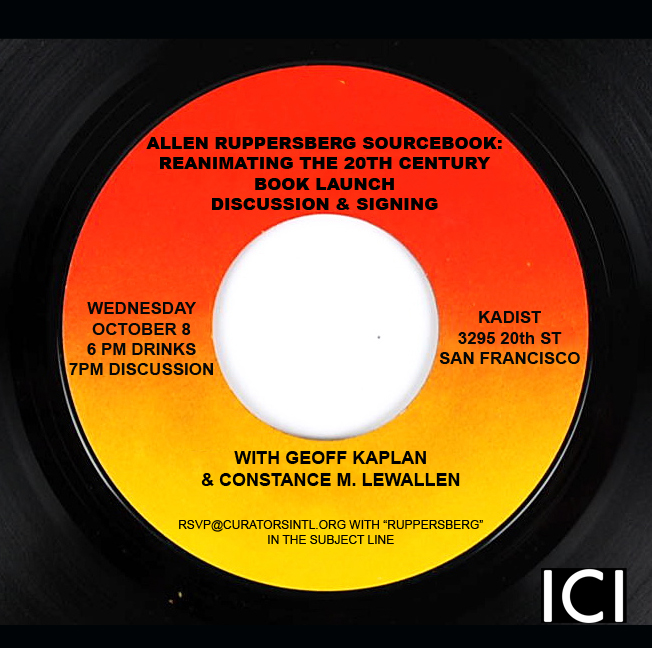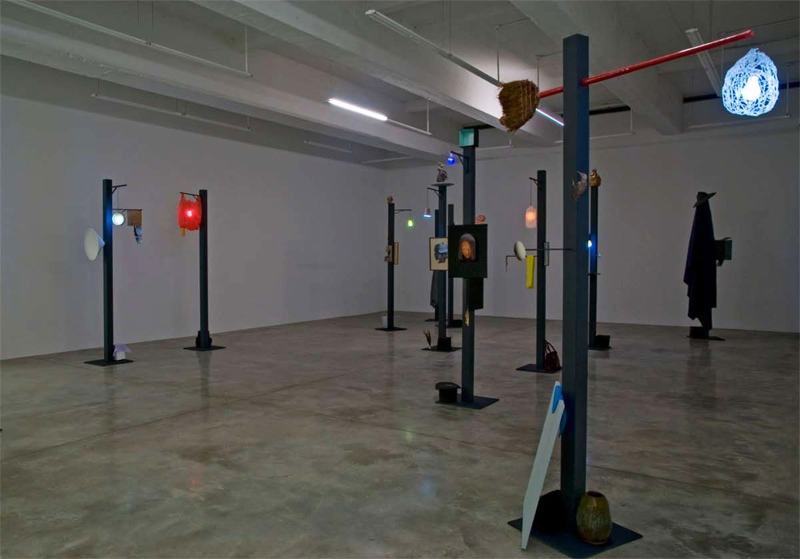
© » KADIST
Yu Honglei
Yu Honglei’s video and mixed media works riff on familiar motifs from the Western art historical canon and reimagine them through a playful but subversive culture jamming of their original meaning. Life (2013), for example, depicts a tiled backdrop of various images and stills associated with the work of American Pop artist Andy Warhol. Digital reproductions of his silkscreens featuring public figures like Elizabeth Taylor, Chairman Mao, and Debbie Harry form an amalgamation of modern art iconography, while repeated images of Warhol himself serve as a constant reminder that even after his death, the artist is still decidedly present in our art historical consciousness.

© » KADIST
Malick Sidibé
Au bord du Fleuve Niger (1976) offers a unique insight into the lives of the 1970s in Bamako. The photograph provides a glimpse into the notoriously active and exciting life alongside the Niger River, where parties would often last until the early hours of the morning. The gaze of the teenage boys who pose for Sidibé bears witness to an intimate space between the lens of the camera, the artist, subjects and the viewer.
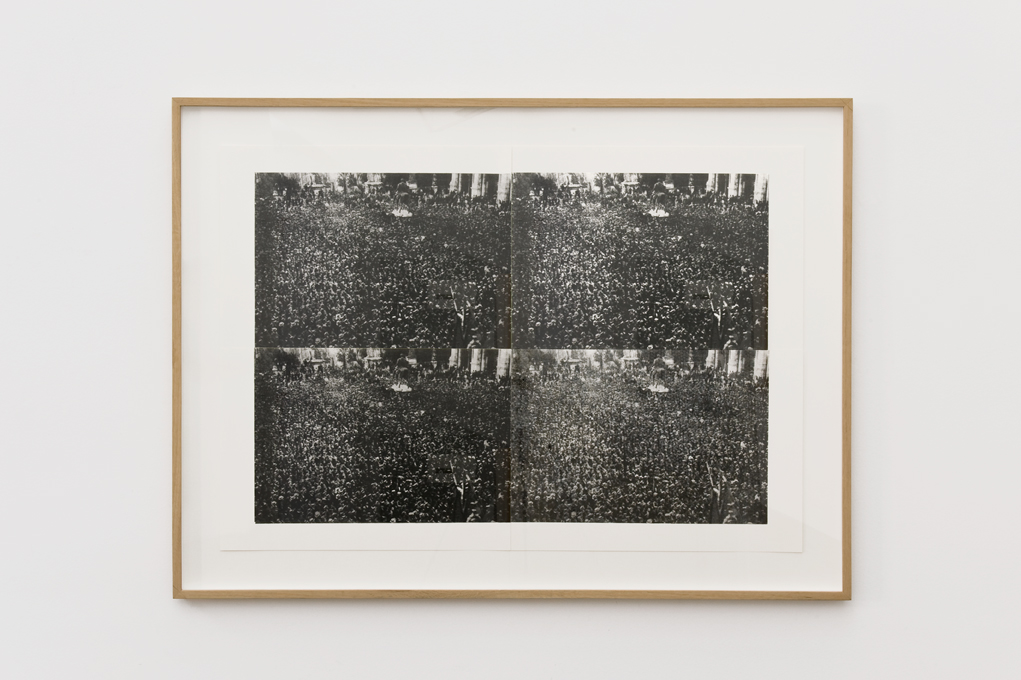
© » KADIST
Asier Mendizabal
Rotation presents the image of a crowd, a re-appropriation of 19th or beginning of 20th century photographs published in newspapers and magazines. This artwork is composed of the same image repeated four times with different resolutions. The last image in Rotation is less focused than the original one.

© » KADIST
David Berezin
In Are You Lonely Mr. Claus? , a bottle of whiskey, a red rose, a lit cigarette, and an assembly of kitschy Christmas memorabilia (Santa’s hat, a sugar cane) are displayed side-by-side with artifacts that denote some sort of (typically Californian?) summer leisure time (sea shells, sun block and goggles).

© » KADIST
Jay Chung and Takeki Maeda
Jay Chung and Q Takeki Maeda remake a clip from the 1970s they found on the internet, and without really changing this archive material, displace it by imitating the staging and the acting with scrupulous precision. The slightest details are reproduced identically with great minutiae. The facial expressions are absurd, the prim attitude makes no sense.

© » KADIST
Yuichiro Tamura
The installation Hey Daddy, Hey Brother comprises a series of “Sukajan” jackets, which Tamura collected over a period of several years. They were a popular souvenir among the US military stations in postwar Japan during the Korean War (1950-1953). With origins rooted in military occupation of in the East Asia region, the jackets fuse the American “bomber,” or baseball jacket, with traditional hand-stitched designs of Japanese iconography, including dragons, tigers, Mt.

© » KADIST
Zach Reini
Particularly shaped by his own youth in the 1990s, his recent works have incorporated things like a marijuana leaf, a dragon-emblazoned chain wallet, metal grommets, and the ubiquitous (in the 90s) Stussy symbol. Reflecting and recouping elements from American youth culture, Reini’s works question how we package, mark, and express ourselves through manufactured symbols of identity. Reini has also used images of Mickey Mouse—Disney’s anthropomorphic icon—in numerous works, including in this pair of works, The More You Want…, …The Less You Get .

© » KADIST
David Berezin
In Eric Goes to Jail , a coffee maker, red lipstick, a pile of cash, some exotic parakeets, a brassiere, a bow tie, and a stained napkin scribbled with a phone number constitute clues to unraveling a mystery and invite the viewer to speculate about the events of the preceding night.

© » KADIST
Yung Jake
I don’t remember is a video by Yung Jake that combines his passion for both music and the visual arts. As per several of his works the video borrows from the vernacular of rap and relies on the aesthetic and stylistic qualities of music videos. A humorous interpretation of the rap and hip hop genres, the video combines scenes from urban settings and snapshots of a party as the artist raps in a drowsy monotone about having forgotten the wild night.

© » KADIST
Yung Jake
As the video Datamosh begins to play, Yung Jake emerges out of a colorful, smoke-like background and breaks into rap. Malfunctioning green screens and pixelated digital mash-ups bleed into each other in a parody of the music video trope and specifically of the trend of ‘datamoshing’—a digital technique commonly used across this genre. The song’s lyrics distinctly borrow from the lexicon of rap, combining mentions of clubs, money and fame, with self-referential and humorous lines that literally describe the way in which the artist subverts the medium.
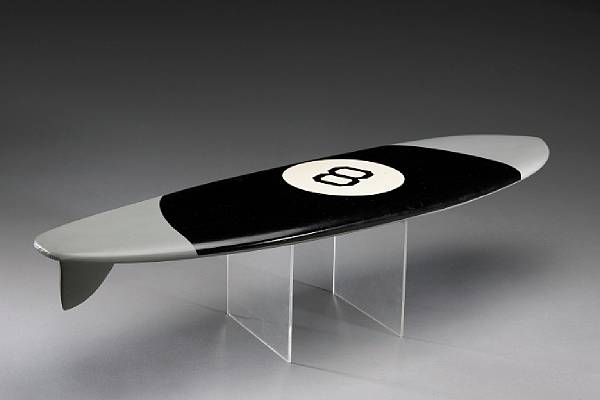
© » KADIST
Alexis Smith
In 8 Ball Surfboard (1995),Alexis Smith combines her long-term interests in California culture and conceptual assemblage. The surfboard, an emblem of Southern California, emblazoned with the image of an eight-ball, references numerous tropes and clichés of American popular culture, specifically subcultures related to pool halls, surfing, and beaches. Indeed, this model-scale surfboard may be a future pop-culture relic, referencing a particular surfer or era of board design.
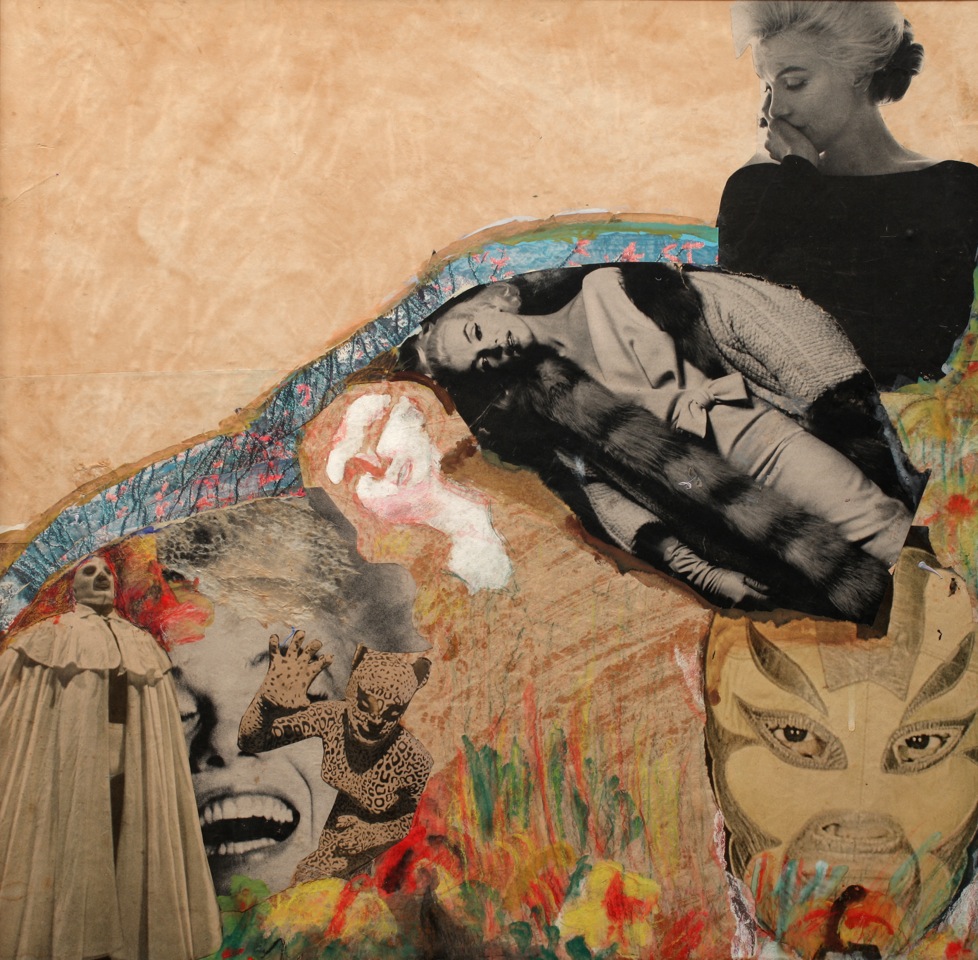
© » KADIST
Fran Herndon
Working independently, Herndon experimented at the forefront of a now-canonical method—appropriation—by painting additions into found images from magazines such as Life and Sports Illustrated in a way that imbues the resulting works with mythical significance. Associated with the Beat movement, her work is integral to that part of the history of San Francisco. White Angel (1962), painted in the year of Marilyn Monroe’s death, portrays the actress in a process of devolution.

© » KADIST
Martine Syms
Her 2016 video installation quotes the sitcom-as-form and also draws from a 1907 comedic short, Laughing Gas. Syms’s 4-channel installation follows the central character (an aspiring artist also named Martine Syms) on a journey home from the dentist after receiving “laughing gas.” Mixing multiple points of view, clips borrowed from TV, as well as layers of comedy, fiction, reality, and critique, Syms’ work also delves into issues of race, culture, and representation. For Los Angeles-based Martine Syms, popular culture, television, and the cultural histories woven through both are starting points for her interdisciplinary art practice.

© » KADIST
Jonathan Hernández
In line with Hernández’s interest in catastrophe, Vulnerabilia (choques) is a collection of images of shipwrecks and Vulnerabilia (naufragios) collects scenes of car crashes. The artist has said that the appropriation of popular imagery is a way for him to take pictures without a camera and to register the things that happen in the everyday as visual essays that evidence the fragility of the world.

© » KADIST
Mario Garcia Torres
Mario Garcia Torres films a game of Charades among professional actors guessing the former North Korean dictator’s favorite Hollywood films. Indeed rather surprisingly Kim seems to have had a huge collection of Western videos and he published a book called “On the art of the Cinema” in 1973. As the final acknowledgments indicate, Garcia Torres’s work was produced following in depth research, consulting information given by director Shin Sang-ok who has been kidnapped by Kim in 1978, as well as Jerrold Post (The George Washington University) and Timothy Savage (Nautilus Institute for Security and Sustainable Development).

© » KADIST
Elisheva Biernoff
In her recent work, Biernoff is interested in investigating fictions and fantasies embedded in the remnants of consumer culture (for example magazines) or through ephemera such as postcards and old photographs. Although the imagery present in her work might seem nostalgic upon first encounter, Biernoff’s complex tableaux often reveal the artist’s skeptical look towards her subjects matters. They Were Here (2010), constitutes a clear example.

© » KADIST
Kota Ezawa
Paint and Unpaint is an animation by Kota Ezawa based on a scene from a popular 1951 film by Hans Namuth featuring Jackson Pollock. At first glance, due to the oversimplified silhouettes Ezawa employs, the connection between his animation and Namuth’s film may not be obvious. However, when seen side by side, Ezawa’s piece is a faithful reproduction of the scene—up until a point in which his sequence begins playing in reverse, effectively unpainting every brushstroke.

© » KADIST
General Idea
AIDS Ring by General Idea is a cast metal ring, which takes as its basis Robert Indiana’s iconic “LOVE” design, appropriating its pop aesthetic, and totalizing, simplistic universal messaging to instead emphasize the severity of the AIDS epidemic that occurred in the 1970s. This visual detournement of Indiana’s sculpture into the form of a ring is an indictment of pop art’s apolitical nature, as well as of its increasingly commodified status. General Idea instead proposes that art’s expansive platform for messaging be used to spread awareness and create accountability for political negligence of the AIDS epidemic.

© » KADIST
Allen Ruppersberg
Untitled (City Limits) is a series of five black-and-white photographs of road signs, specifically the signs demarcating city limits of several small towns in California. Taken outside Palmdale, Littlerock, Pearlblossom, Victorville, and Barstow, towns where the population does not exceed 20,000, Ruppersberg’s trip follows the outskirts of Los Angeles. As with many of his other photographic series, the artist here inserted into each view a constant element that disturbs the otherwise quiet scenes: a hand holding an open magazine.
Yung Jake
Yung Jake is a visual artist and YouTube rapper based in Los Angeles whose work fuses new media, music, and art...
David Berezin
David Berezin takes advantage of the language of popular culture and our overexposure to it...
Yuichiro Tamura
Yuichiro Tamura works in a wide range of media including video, photography, installation and performance...
Mario Garcia Torres
- location: Mexico City, Mexico
- year born: 1975
- gender: male
- nationality: Mexican
- home town: Monclova, Mexico
Alexis Smith
- location: Los Angeles, California
- year born: 1949
- gender: female
- nationality: American
- home town: Los Angeles, California
Kota Ezawa
- location: San Francisco, California
- year born: 1969
- gender: male
- nationality: German
- home town: Cologne, Germany
Allen Ruppersberg
- year born: 1944
- gender: male
- nationality: American
- home town: Cleveland, Ohio
Yu Honglei
Yu Honglei produces video and mixed media works that frequently take everyday objects as their starting points...
Zach Reini
In the work of American artist Zach Reini, elements of recent pop culture mix with art historical references to create works tinged with playfulness and darkness...
Paul McCarthy
- location: Los Angeles, California
- year born: 1945
- gender: male
- nationality: American
- home town: Salt Lake City, Utah
Asier Mendizabal
Asier Mendizabal explores political subjects and their symbols...
Martine Syms
- location: Los Angeles, California
- year born: 1988
- gender: female
- nationality: American
- home town: Los Angeles, California
General Idea
The Canadian artist collective General Idea (Felix Partz, Jorge Zontal and AA Bronson), active from 1967-1993, was an instrumental source of early conceptual art through their multidisciplinary practice...
Jay Chung and Takeki Maeda
Jay Chung and Takeki Maeda’s practice is characterized by performance, which often involves weighty unsettling humour...
Fran Herndon
Fran Herndon was born in Oklahoma in 1929, then moved to San Francisco in 1957, where she came into contact with Jack Spicer, who encouraged her painting practice by motivating her to study at the California School of Fine Arts (now the San Francisco Art Institute)...

© » KADIST
about 3 months ago (02/12/2024)
OCAT Shanghai and KADIST are pleased to announce that Wang Tuo has been selected for a research residency at KADIST San Francisco as part of the OCAT x KADIST Emerging Media Artist Residency Program 2020 The artist was selected by an esteemed international jury from the shortlist of artists selected for the Emerging Media Artist Exhibition 2020...
-
1960-1969
Fran Herndon
1962Working independently, Herndon experimented at the forefront of a now-canonical method—appropriation—by painting additions into found images from magazines such as Life and Sports Illustrated in a way that imbues the resulting works with mythical significance...
-
1970-1979
Allen Ruppersberg
1970Untitled (City Limits) is a series of five black-and-white photographs of road signs, specifically the signs demarcating city limits of several small towns in California...
Malick Sidibé
1976Au bord du Fleuve Niger (1976) offers a unique insight into the lives of the 1970s in Bamako...
-
1990-1999
General Idea
1993AIDS Ring by General Idea is a cast metal ring, which takes as its basis Robert Indiana’s iconic “LOVE” design, appropriating its pop aesthetic, and totalizing, simplistic universal messaging to instead emphasize the severity of the AIDS epidemic that occurred in the 1970s...
Alexis Smith
1995In 8 Ball Surfboard (1995),Alexis Smith combines her long-term interests in California culture and conceptual assemblage...
-
2000-2009
Mario Garcia Torres
2005Mario Garcia Torres films a game of Charades among professional actors guessing the former North Korean dictator’s favorite Hollywood films...
Jonathan Hernández
2008In line with Hernández’s interest in catastrophe, Vulnerabilia (choques) is a collection of images of shipwrecks and Vulnerabilia (naufragios) collects scenes of car crashes...
Jay Chung and Takeki Maeda
2009Jay Chung and Q Takeki Maeda remake a clip from the 1970s they found on the internet, and without really changing this archive material, displace it by imitating the staging and the acting with scrupulous precision...
Elisheva Biernoff
2009In her recent work, Biernoff is interested in investigating fictions and fantasies embedded in the remnants of consumer culture (for example magazines) or through ephemera such as postcards and old photographs...
-
2010-2019
David Berezin
2010In Eric Goes to Jail , a coffee maker, red lipstick, a pile of cash, some exotic parakeets, a brassiere, a bow tie, and a stained napkin scribbled with a phone number constitute clues to unraveling a mystery and invite the viewer to speculate about the events of the preceding night....
Asier Mendizabal
2012Rotation presents the image of a crowd, a re-appropriation of 19th or beginning of 20th century photographs published in newspapers and magazines...
Yu Honglei
2013Yu Honglei’s video and mixed media works riff on familiar motifs from the Western art historical canon and reimagine them through a playful but subversive culture jamming of their original meaning...
Kota Ezawa
2014Paint and Unpaint is an animation by Kota Ezawa based on a scene from a popular 1951 film by Hans Namuth featuring Jackson Pollock...
Zach Reini
2015Particularly shaped by his own youth in the 1990s, his recent works have incorporated things like a marijuana leaf, a dragon-emblazoned chain wallet, metal grommets, and the ubiquitous (in the 90s) Stussy symbol...
Martine Syms
2016Her 2016 video installation quotes the sitcom-as-form and also draws from a 1907 comedic short, Laughing Gas...
Yuichiro Tamura
2017The installation Hey Daddy, Hey Brother comprises a series of “Sukajan” jackets, which Tamura collected over a period of several years...



